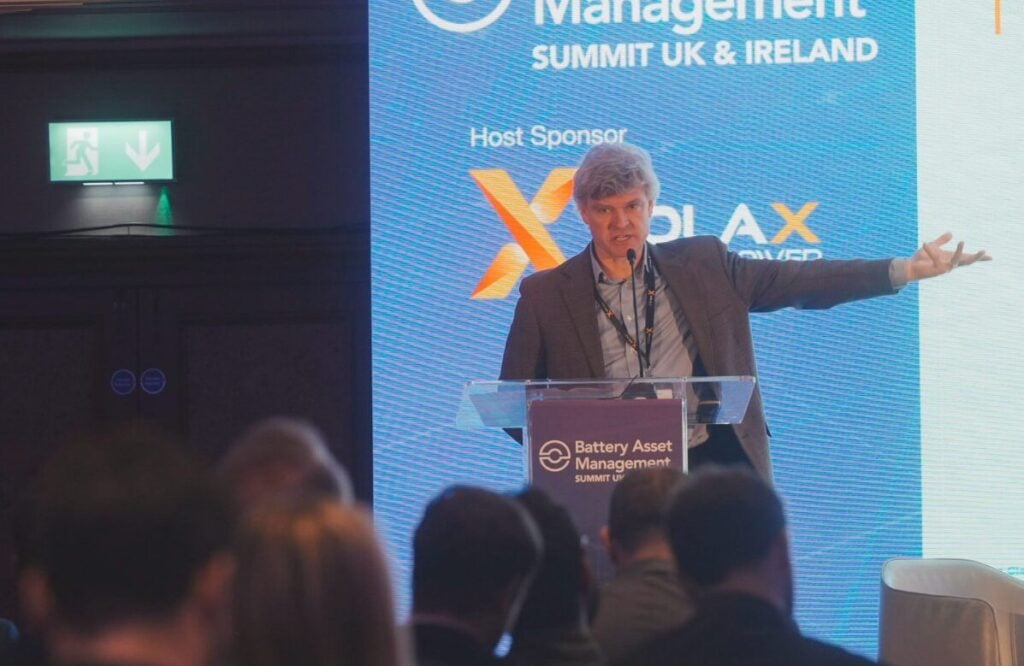
The value of developers and optimisers in the BESS lifecycle, thinking about long-term risk and KPIs for maximising the asset have been key themes at the Battery Asset Management Summit UK & Ireland 2025.
The topics came up on the ‘Evolving Stakeholder Interests Through the Asset Lifecycle’ panel discussion on Day One the two-day event in London yesterday (15 October), which brings together stakeholders to discuss asset management, optimisation and lifecycle maximisation in the battery energy storage system (BESS) industry.
We also heard from Fernando Casas Garcia, head of operations & asset management for asset manager Gresham House, the largest owner-operator of UK BESS via its Gresham House Energy Storage Fund. Garcia also spoke on the ‘Lessons Learned from the Veterans – The Yeses, the Nos & the Maybes’ panel this morning.
Developers’ role
Panel moderator Roberto Castiglioni, co-founder and CEO of developer Ikigai Group, opened up the discussion with an audience poll asking: ‘Which stakeholder group is currently the most undervalued in the BESS lifecycle?’
Try Premium for just $1
- Full premium access for the first month at only $1
- Converts to an annual rate after 30 days unless cancelled
- Cancel anytime during the trial period
Premium Benefits
- Expert industry analysis and interviews
- Digital access to PV Tech Power journal
- Exclusive event discounts
Or get the full Premium subscription right away
Or continue reading this article for free
The poll results suggested the audience thought it was operators, while Rob said in his view it was optimisers and that developers should also get more credit.
In response, investor Schroders Greencoat’s investment director Matt Tingle discussed the value of developers.
“It depends who the developer is. We like paying a good developer premium for the right project,” he said.
“It’s the really experienced, considerate developers that have thought about the location, the cost of the connection, and got an early one. And those that have actually thought about future-proofing the system, for example, getting enough land to actually be able to increase the duration from maybe two hours to four hours or beyond over time.”
“For developers’ assets, if there additional value that those assets could capture in the markets, which other projects couldn’t, there’s a potential addition to what you can get paid,” investor CVC DIF’s investment director for storage Loic Cerulus said.
“There’s quite a wide range of how projects get valued in the market. Generally, you just look at performance, if you’re good at what you do, then I think there’s a discussion to be had and maybe we can pay you a bit more.”
Long-term risk
Tingle then answered a question from Castiglioni about how he, as an asset owner, thinks about the long-term risk of market saturation.
“It has to be about the market fundamentals: looking at the increasing rollout of renewable energy which is only expected to continue. Ultimately, that will continue the volatility, so it’s just a question of how much and what does that mean in terms of revenue? Also, it’s about looking at the optimiser strategy, not just for maximising revenue, but for thinking about longevity factory as well,” he said.
As other BESS owner-operators have done so recently, Tingle also asked question of what the UK’s long-duration energy storage (LDES) cap and floor scheme will do to the market, as it will subsidise some BESS projects too.
Casas Garcia, in response to a question around this, said: “Contracted revenues enable BESS to achieve more predictable IRRs. This results in a higher leverage ratio, improved debt conditions, and increased overall investment potential. These outcomes will remain feasible as long as BESS prices continue to decline.”
Interestingly, Gresham House was one of the signatories to an open letter opposing the LDES scheme because of concerns over unfair competition for winning projects versus other BESS assets.
Main KPIs for BESS asset management
“The most important indicator is uptime. As the usage of these technologies has evolved since their purchase or installation, some issues have arisen related to imbalance,” Casas Garcia said.
“Focusing on balancing the racks and PCSs is crucial for ensuring optimal performance of the assets. On the commercial side, key performance indicators (KPIs) such as degradation, skip rates, response time are also very important.”
The panel also discussed KPIs and how optimisers fit into this. Tingle said that it was key to look for an optimiser that is proactive in identifying availability issues, tracking things like state of charge (SOC) and generally being aware of what’s on the ground.
“There are different views on whether optimisers are going to ultimately homogenise and automate more and more, with less of a sort of personal level of optimization. But I think those that can demonstrate that productivity and engagement with their clients are the ones that are going to succeed,” he said.
Cerulus pointed to response time to issues as an extremely important KPI. “Ultimately you want these assets to be available as often as possible. You make outsized returns during system stress events and don’t want your assets down at those times. So having good engagement from your technical asset operators is key.”
